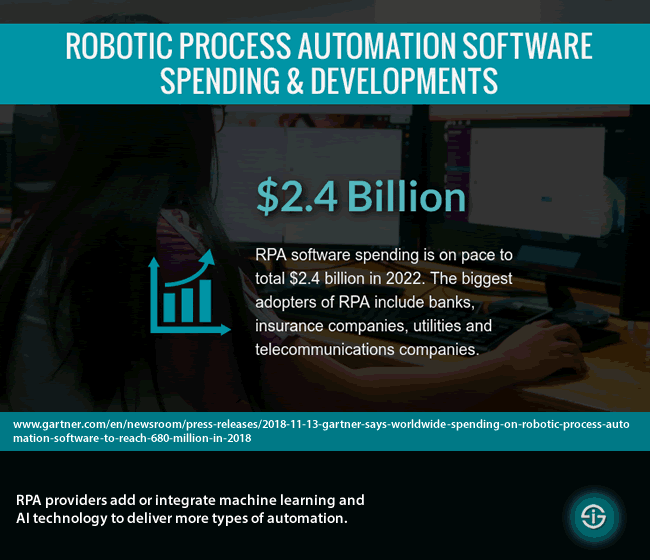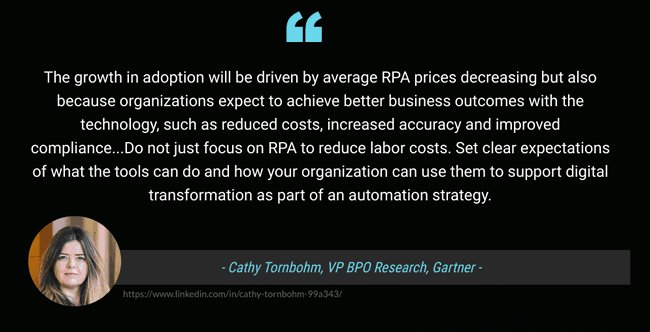Spending on robotic process automation or RPA software is on pace to total $2.4 billion in 2022. That’s one of the takeaways from a Gartner announcement on the state of the market. An overview with some trends in the RPA software vendor space.
RPA software plays an important role in today’s digital transformation technology tool set. The fast growing adoption of robotic process automation is clear in the expectations for the following years with various market drivers of which some are mentioned below.
By the end of 2022, 85 percent of large and very large organizations will have deployed some form of RPA.
Good times for RPA software vendors, especially as a lot of companies haven’t started yet and in those that did there are still ample areas where employees ‘execute mundane tasks that require them to cut, paste and change data manually’ and RPA tools can shrink error margins and increase data quality.
Moreover, verticalization opportunities certainly aren’t fully explored yet, go-to-market approaches are being expanded with channel partners and providers of other systems and technologies in a market that is in full flux.

Both software providers and clients see that the big opportunities in the end are about an integrated automation approach.
Whereas several organizations are considering RPA implementations in those types of tasks/processes where it makes most sense and value is highest, the journey towards integrated automation and intelligent automation or cognitive automation (with ‘newer/better’ forms/types of artificial intelligence on top of the basic ones which we’ve known in the information management and capture space since quite some time) is an ongoing one.
RPA software – knitting together elements of applications and automating manual tasks
Organizations also start realizing that the value of RPA software is in more integrated deployments at scale. Moreover, from the perspective of knowledge workers RPA and intelligent automation fit in a scope of several “augmenting” technologies that go beyond repeatable tasks.
So, it’s not surprising that RPA software vendors are broadening their ecosystem partnerships while also focusing on verticals. Verticals – processes and sectors – bring us back to the findings of Gartner. The biggest adopters of RPA software today include banks, insurance companies, utilities and telecommunications companies the research firm says.
RPA solutions perform best when an organization needs structured data to automate existing tasks or processes, add automated functionality to legacy systems and link to external systems that can’t be connected through other IT options.
Gartner VP Cathy Tornbohm comments: “Typically, these organizations struggle to knit together the different elements of their accounting and HR systems, and are turning to RPA solutions to automate an existing manual task or process or automate the functionality of legacy systems”.
The company also points to the mentioned emerging market movement; whereby artificial intelligence functionalities get integrated into the product suite of RPA tools providers. This is happening because RPA providers add or integrate machine learning and AI technology to deliver more types of automation the company states (this is also the area where intelligent automation, cognitive automation etc. come in).
Decreasing prices of RPA software add to the business drivers of RPA software spending
Gartner estimates that by the end of 2022, 85 percent of large and very large organizations will have deployed some form of RPA software.
Cathy Tornbohm comments: “The growth in adoption will be driven by average RPA prices decreasing by approximately 10 percent to 15 percent by 2019, but also because organizations expect to achieve better business outcomes with the technology, such as reduced costs, increased accuracy and improved compliance”.
The research firm also reminds that RPA isn’t a one-size-fits-all technology, and of course it is suited for specific tasks/processes as we previously wrote.
Gartner expects that current leaders in the robotic process automation vendor market (a few of the better-known RPA software providers and software vendors with RPA tools include Automation Anywhere, Blue Prism, Datamatics, IBM, Kofax, NICE, Pega, UiPath and WorkFusion, to cite a few in alphabetical order) will see more players entering the space. And how else could it be, given market forecasts?

Finally, a few words on where RPA tools are positioned in the Gartner Hype Cycle for Artificial Intelligence (2018): at the time of the announcement which you find here Gartner felt they resided at the Peak of Inflated Expectations, ‘as organizations look for ways to cut costs, link legacy applications and achieve a high ROI’. RPA is on its way to mainstream adoption.
In order to make an RPA project a success, leaders must first evaluate the possible use cases for RPA in their organization and also focus on revenue-generating activities.
Cathy Tornbohm: “In the near-term future, we expect to see an expanding set of RPA vendors as well as a growing interest from software vendors, which include software testing vendors and business process management vendors that are looking to gain revenue from this set of functionality”.
RPA software spending has been forecasted to reach close to $4 billion by 2025 according to other research. Yet, the market evolves so fast that those forecast periods might be too long. Meanwhile it’s clear that the market is set for further fast adoption and evolution on the road to integrated automation and that the different existing players – and new players – still have ample room for growth.
Gartner clients, looking for strategic deployment advice and for market evolutions can learn more in the report “Robotic Process Automation: 8 Guidelines for Effective Results,” and “Forecast Snapshot: Robotic Process Automation, Worldwide, 2018 Update.”
All images are property of their respective mentioned owners.

